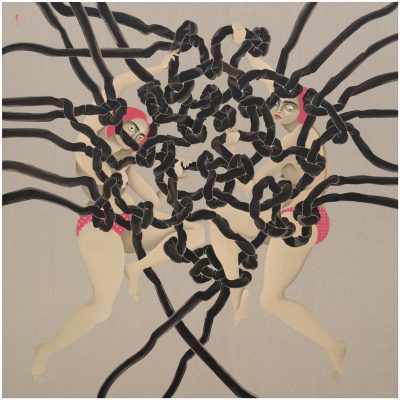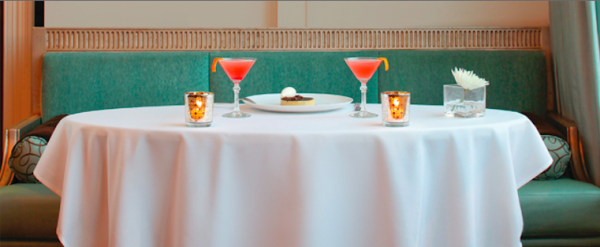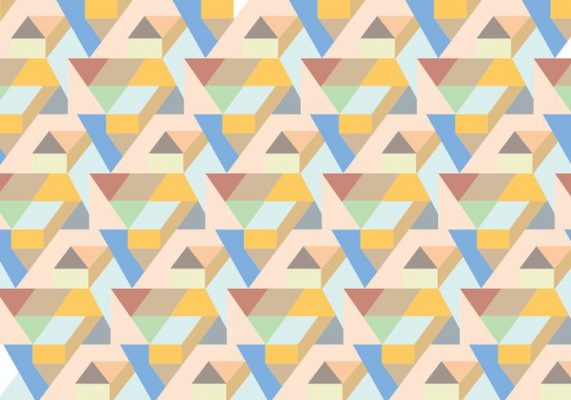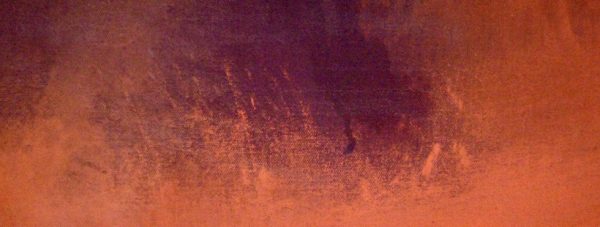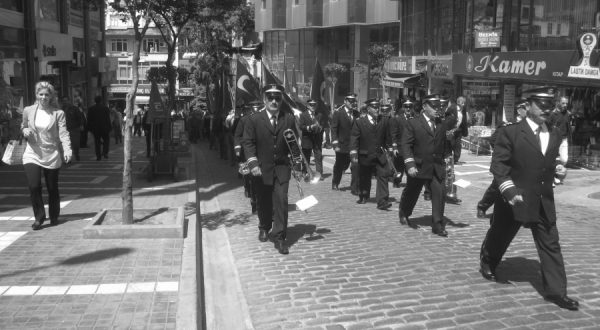In Hayv Kahraman’s vast painting, ‘Entanglements no.1’ (2021), all life is suspended. Two female figures, weightless though weighed down, are enchained in a series of interlocking intestinal knots. Thick dark coils, bigger than a clenched fist, tighter than the developing grip this work has on you, curl around feet and hands. Caught and contained in a prison not of their own making, the women cling to the tubular cords, peering at the viewer from behind this oppressive net.
Overwhelming in scope and size, ‘Entanglements no.1’ commands my attention, luring my gaze into its tense twists and dense depressive curlicues. This mesmeric encounter leaves me to ask who is ensnaring who? Am I entangled or are Kahraman’s women? Are they clinging on for dear life or desperately trying to get out? This ambiguity is accentuated so that we, like her women, are forced to confront the troubling position of being psychologically and physiologically stuck. Is healing to be found in the digressive digestive passages palpably found and felt in her works? Or are we, too, destined to be trapped in the neurotic networks of our own bodies and minds?
Gut Feelings (2022), a solo exhibition of Kahraman’s paintings and mixed media works at the Mosaic Rooms in London, explores this blurring of inner and outer, of space and form. Spread across three galleries, the exhibition disentangles the ties of trauma through a visual synecdoche of thick black cords – at once reminiscent of neurons and the gastrointestinal tract – snaked around and protruding out of female bodies. Inspired by neuro-sculpting and psychotherapeutic neurological models espoused by trauma therapists Bessel van der Kolk and Resmaa Menakem, Gut Feelings embraces the intersection between the socio-cultural and the biological, between effects and their affective imprints, between external sites and our internal, somatically-held responses to them.
To be ensnared by Kahraman’s work, much like her female figures, is, therefore, to work through the muck of our own gut. In all their vertiginous, hypnotic intensity, many of the paintings, like ‘Entanglements no.1’, pull us further and further into this visceral psycho-biological journey, pushing us to confront the deep relationship between gut and mind, as well as the medico-philosophical history behind the two. For Kahraman, an Iraqi artist who has experienced the violence of war and displacement, disentangling this history through her works is integral to both uncovering and recovering the narrative around marginalised bodies.
‘Entanglements with torshi’ (2021) is the first work to centre the gut in the process of psychological reconfiguration. Crouching close to the soil, four women busy themselves with the handling of a pinkish-mauve duodenum-like rope. Positioned in an asymmetric crucifix formation, the women gently knead and caress the intestinal cord, which is wound around their heads. Less threatening than the dark matted mesh in ‘Entanglements no.1’, the lightly coloured cordon in ‘Entanglements with torshi’ stresses the positive and nourishing symbiosis of brain and gut through Kahraman’s application of food colourant. Made with the dye of torshi – a Middle Eastern dish consisting of beetroot and turnip which, via the gut, improves mental wellbeing – the cord doubles as a neural linkage. With their eyes averted from each other and the viewer, the women quietly and methodically go about this traditional indigenous ritual of healing. Appearing to us as if freshly uprooted from the soil, the women rework, re-root and re-route their own relationship to past trauma. This is a unifying act, a procedure acted in silent solidarity, solidifying their relationship to their own selves, their own bodies and each other by remaining close to the source of both pain and healing: the bowels of the earth. In cultivating both crop and its edifying effects to their own minds and bodies, Kahraman’s displaced figures carefully look back to the waste and fruit of now far off lands. Looking into themselves, into the neural and psychic terrain that the torshi conjures and evocatively points towards, the women return home.
In its use of tradition and food, ‘Entanglements with torshi’ posits the possibility of rebirth, renewal and re-harmonisation. Yet not all of Kahraman’s paintings envisage this process of healing and neuro-physiological balance with the same sense of care or calm. Like ‘Entanglements no.1’, a melancholic unspooling of gastrointestinal tubes takes over the foreground in ‘Play Dead’ (2021). Cascading out of the central figure’s stomach, the elongated chain of pain buries all in its path. Such a work troubles the humble yet reassuring ritual performed in ‘Entanglements with torshi’ and reminds us that the return or re-enactment of trauma can feel all too unbearably real. Quite often it feels, as the well-known idiom goes, gut-wrenching.
One of the most stomach-churning suite of paintings to look at, however, is the triptych, ‘Neuro-bust’ (2021). Here three female heads are precariously placed on metal poles like classical busts, while the same tar-like tubes and colonic (colonial?) cords emerge from their mouths and drape, serpent-like, around their shoulders. This is Kahraman interrogating Western epistemological systems – and institutions – that have force-fed – as well as fed off – the bodies and minds of women of colour. Suffocated, violated, rendered voiceless, armless, legless, the female heads can only talk and act back through Kahraman’s – and our – witnessing of this torturous imbibing and forced internalisation of knowledge.
There is, in ‘Neuro-bust’, protest too, as hinted at by its punning title – though the ‘busting’ that Kahraman is talking about is one of long-held colonial myths and dangerous associations involving the consumption, objectification, sexualisation and fetishisation of women of colour. Such heinous mythologies, perpetuated by medical, philosophical and ethnographic writings throughout history, are exposed here for the grotesque and shameful fantasies they are. Viewed as an interconnected assemblage, the busts confront such myths and denounce such violence in a gloriously gory, peristaltic manner. Literally spilling their guts, the figures in ‘Neuro-bust’ reveal these systems of knowledge to be, quite literally, busted.
Like ‘Entanglements no.1’, ‘Neuro-bust’ has the same paradoxical pull on the viewer. Revolted by what we see, we peer into the work and ponder, allowing Kahraman to intellectually bust our preconceptions, our own colonial gaze, our own gutturally-felt and neurologically wired prejudices. Uncannily regurgitating our own ideas, Kahraman cannily invites us to reevaluate how we think and view and treat the vulnerable bodies of women – and marginalised peoples generally. By radically reclaiming the gut as an alternative epistemological system through which to develop, digest and channel new thoughts and feelings, Kahraman is asking us to get down and dirty in our own mucky, gut-twisting history.
And it is the muck of the gut – or rather its healing properties – that Kahraman returns us to in the basement of the Mosaic Rooms. Using handmade flax as a surface upon which to paint, she demonstrates how microbes are integral to improving our mental and physical health. Before being woven and spun into linen, the flax is harvested by bacteria in the soil – colonist microbes to be doubly subversive. Such bacteria are, of course, essential to preserving the health of the gut, and, in turn, our psyches. Hence, by bringing us down, into the belly of the beast, or rather a space covered from floor to ceiling in this glistening, earth-harvested linen, Kahraman encourages us to confront our own trauma, to discover our own healing in the mucky, bacteria-laden entrails of our own selves.
Hanging from the glimmering, linen-strewn gallery are strips of flax containing ink drawings of more women. Though now microscopically diminutive in size and stature, they twirl ecstatically around oesophagi-like threads, spinning and unfurling from their contorted positions of past pain. On flaxen hangings, larger forms loom, no longer intimidated or cordoned off by the bindings of hurt and fear. Instead, they resume the squatting posture (is it not at once a pose of excretion and birthing too?) of the women in ‘Entanglements with torshi’, tranquilly and carefully holding the umbilici to their former selves. Taking it back to the earth, to the terra incognita, to the bacterial diamonds buried deep in the ground – and the brilliant base depths of ourselves – Kahraman designs a blueprint for moving from hurt to healing; she constitutes a corpus of work that maps out the biological and neurological body’s passage to new life. She liberates us from the terrifying bonds and barricades of trauma, as glimpsed in her mesmerising painting ‘Entanglements no.1’, and into the liberating potential of our own bodies and lands. Creating an ecology that positions the gut as a crucial meeting point for inner and outer change, Kahraman’s Gut Feelings delivers us into the light, calmative surroundings again, with a greater sense of what it is to breathe, move, squat and dance unencumbered.
